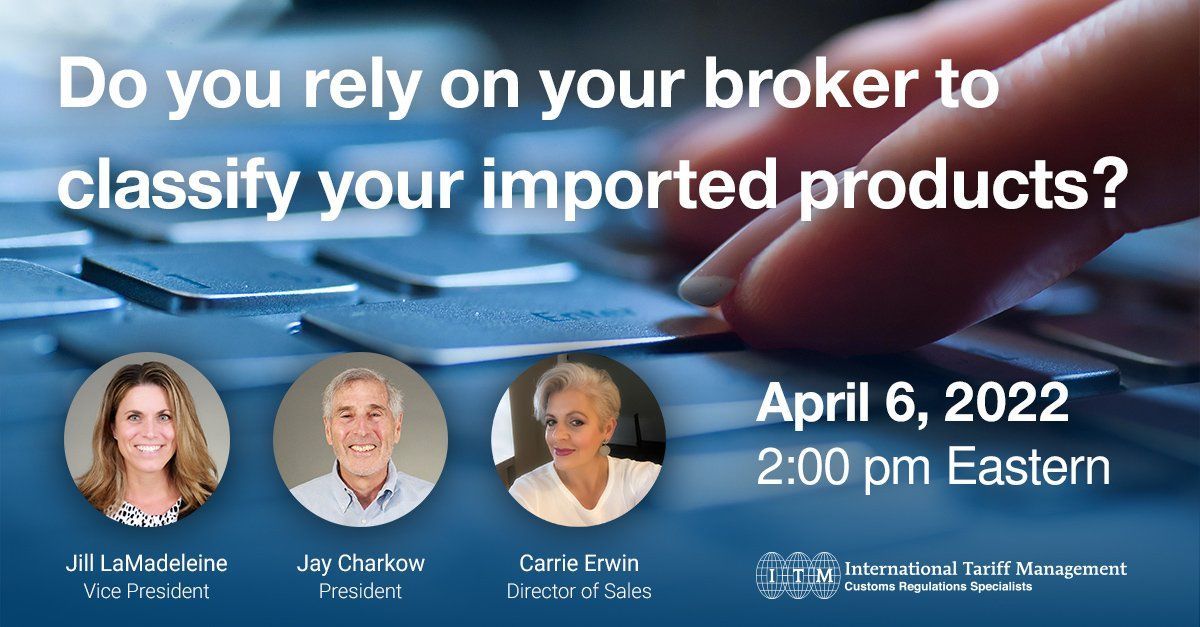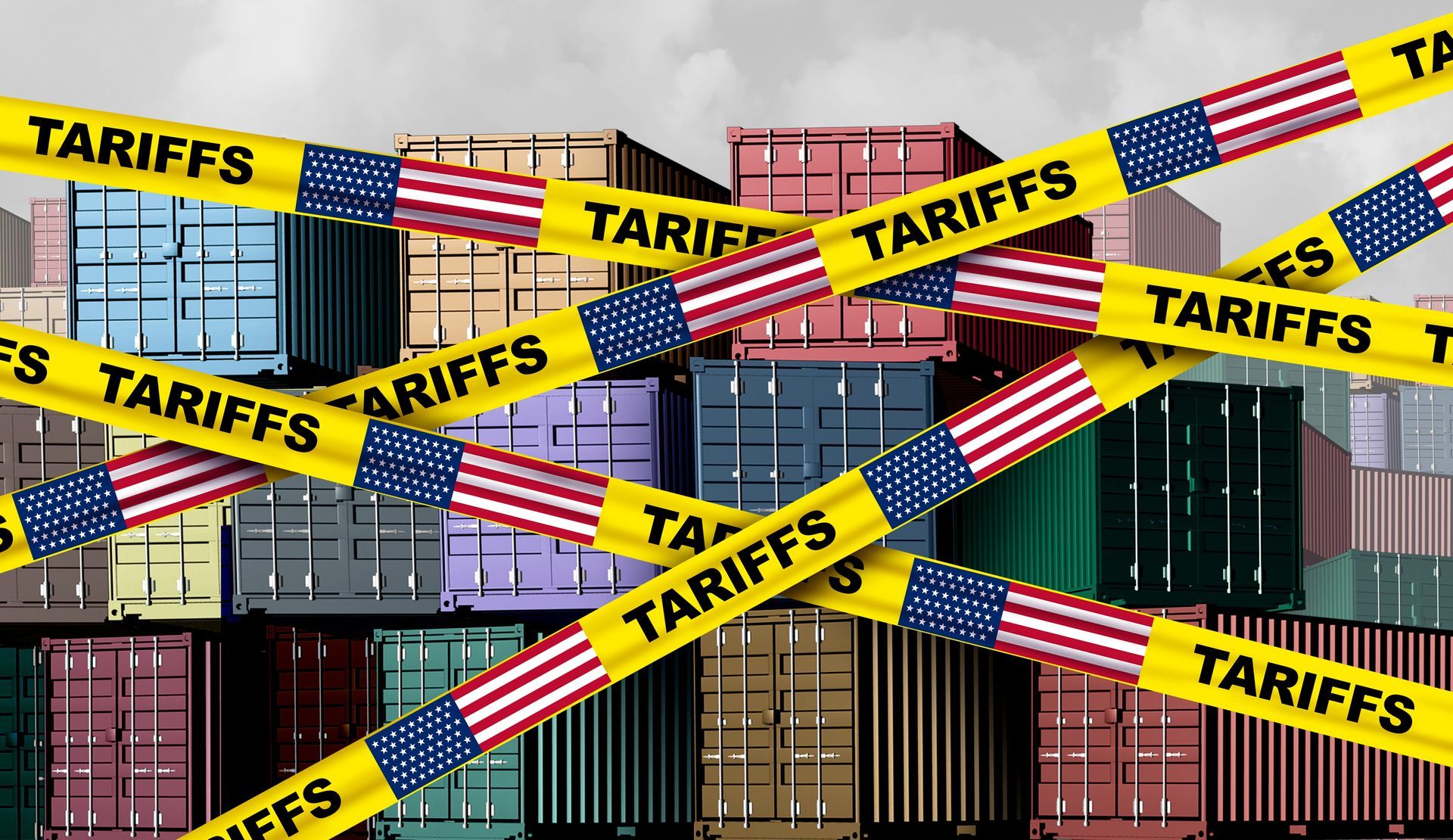Do you rely on your broker to classify your imported products?
March 28, 2022
How proper classification can equate to big savings for your company.
Do you import? Do you rely on your broker to classify your imported products?
Import brokers have a general understanding of the Harmonized Tariff Schedule of the United States (HTSUS), and classify thousands of separate items across hundreds of different industries. But do they really know what your products are or how they are intended to be used?
The classification process is extremely intricate and requires an understanding of both the HTSUS and the merchandise being classified. We at ITM have been classifying merchandise according to the HTSUS for nearly 40 years and in doing so have found that a lot of merchandise is not always classified correctly.
In order to properly classify an imported item, one must understand how to navigate the HTSUS that includes over 10,000 classifications that are broken down by Sections, Chapters, Headings and ultimately Subheadings. Subsequently, one must also understand what the product is, what it is used for and how it is made. For items that are not very specifically provided for, the process is very complex and quite often mistakes are made.
A lot goes into an accurate analysis and classification. A common misconception is that every item is accounted for in the HTSUS. This is not the case. More often than not, an evaluation involves a significant knowledge of the product itself to determine where it belongs. A product may be designated in the HTSUS according to what it is but it can also be defined according to how it is used.
An inaccurate classification, causing an underpayment of duty, can result in the burden of monetary penalties as well as an interruption of receipt of your merchandise. Conversely, an incorrect classification where too much duty is paid, is giving away money that could fall to your organization’s bottom line.
Not everything is misclassified. 90% of imported merchandise is classified properly. Of the 10% that is improperly classified, 80% results in millions of dollars of over-payment of duties.
The importer is obligated to properly classify imports even if there is no change in the duty rate. Therefore, in order to be compliant, it is imperative that importers exercise their due diligence to ensure that their items are properly assigned upon importation.
An importer should initiate periodic reviews of the classification of merchandise. CBP reviews merchandise on a daily basis and writes hundreds, if not thousands, of rulings as to their positions on how individual items should be classified. As these change over time, you should review your classifications regularly in order to remain compliant and up to date. A specific item classified under one HTSUS number last year might have a totally different HTSUS today.
Don’t settle for generic. Demand an in-depth analysis of your products when determining how they fit into the HTSUS. ITM specializes in providing a meticulous evaluation of your product while determining the precise tariff classification.
A portion of the millions of dollars of overpaid duties might be yours!
Join our webinar and learn how proper classification can equate to big savings for your company - join our webinar:
Join our webinar and learn how proper classification can equate to big savings for your company - join our webinar:
Get actionable advice on cost-saving strategies that boost your bottom line.
Subscribe here:

The latest on the reciprocal tariffs have them hanging in the balance. On August 29, 2025, the U.S. Court of Appeals for the Federal Circuit, affirmed a lower court decision finding that the reciprocal tariffs exceeded presidential authority under IEEPA. The court stayed its mandate until October 14, 2025, giving the g

On July 27th, the Trump Administration announced a deal with the EU imposing tariffs of 15% on most goods entering the US from Europe. As of August 1st, the 15% blanket tariff will cover most US imports. The US will have a 0% tariff for some items including equipment for US manufacturing and generic medicines.

The American company reached out to ITM for guidance. They were pleased to learn that under U.S. Customs regulations, they could file for duty drawback—a refund of duties paid—on expired and destroyed goods. Within just four months, ITM had successfully obtained the required authorizations and filed all claims related to the product destructions. Due to ITM’s relationship USCBP, and their expertise, over $850,000 in duty refunds was recouped.

On May 28, 2025, a U.S. trade court ruled that President Donald Trump over stepped his authority in imposing the reciprocal tariffs. At that time, the court ordered an immediate block on said tariffs. As of May 29, 2025 a federal appeals court temporarily reinstated the most sweeping of Trump's tariffs. Pausing the lower court’s ruling, The United States Court of Appeals for the Federal Circuit in Washington is going to consider the government's appeal, and has ordered the plaintiffs in the cases to respond by June 5 and the administration by June 9. This is a developing situation and we will do our best to keep the information coming.

This jewelry retailer's duty drawback success story demonstrates the significant impact that a well-managed duty drawback program can have on profitability. By recovering significant funds, the jewelry retailer was able to reinvest in their business, enhance competitiveness, and strengthen their bottom line in a challenging market.

As of 12:01am, March 4, 2025, tariffs of 25% are effective on products from Canada and Mexico and energy products from Canada are subject to a 10% duty. Products that are presently excluded from these tariffs include goods that are for personal use, goods entered under Chapter 98, donations that are imported under HTSUS 9903.01.21and merely information items included under HTSUS 9903.01.22. All other imported items will carry the 25% tariff and no drawback is permitted on these duties.

The upcoming changes to steel and aluminum tariffs will significantly impact the steel and aluminum industries, with numerous provisions to ensure compliance. Importers, exporters, and manufacturers in the steel and aluminum sectors should stay informed about the latest developments and ensure their operations are aligned with these new tariff regulations.

On February 1, 2025, President Trump signed an Executive Order (EO) that imposes an additional 10% ad valorem tariff on most imports from China, which includes products of Hong Kong. U.S. Customs and Border Protection (CBP) quickly followed up with important guidance regarding these changes, particularly impacting the trade community's handling of de minimis shipments from China. Effective February 4, 2025, de minimis shipments from China will no longer be eligible for the administrative exemption from duty under 19 U.S.C. § 1321(a)(2)(C), and will be subject to the new 10% tariffs. Here's everything you need to know about the changes:













